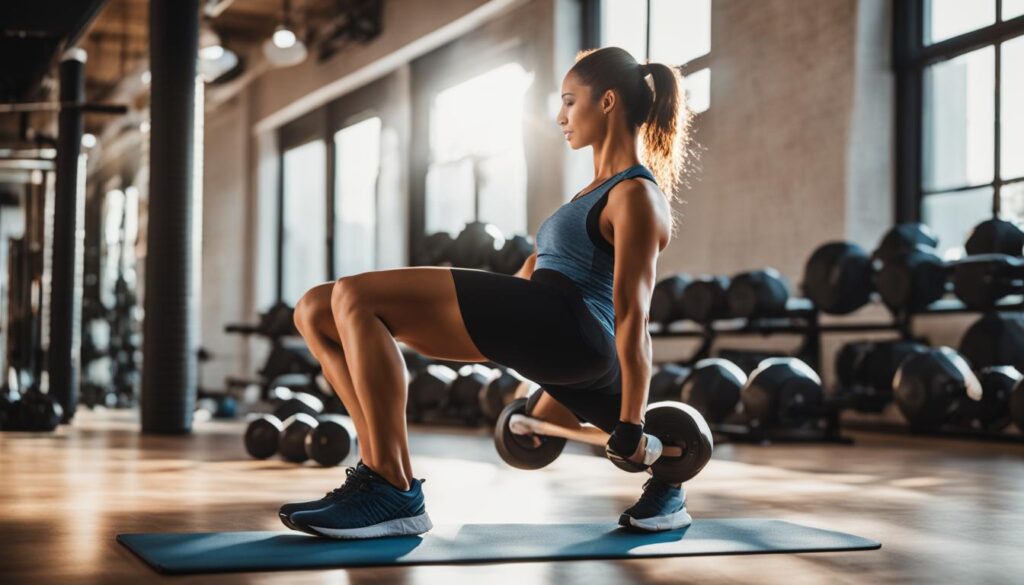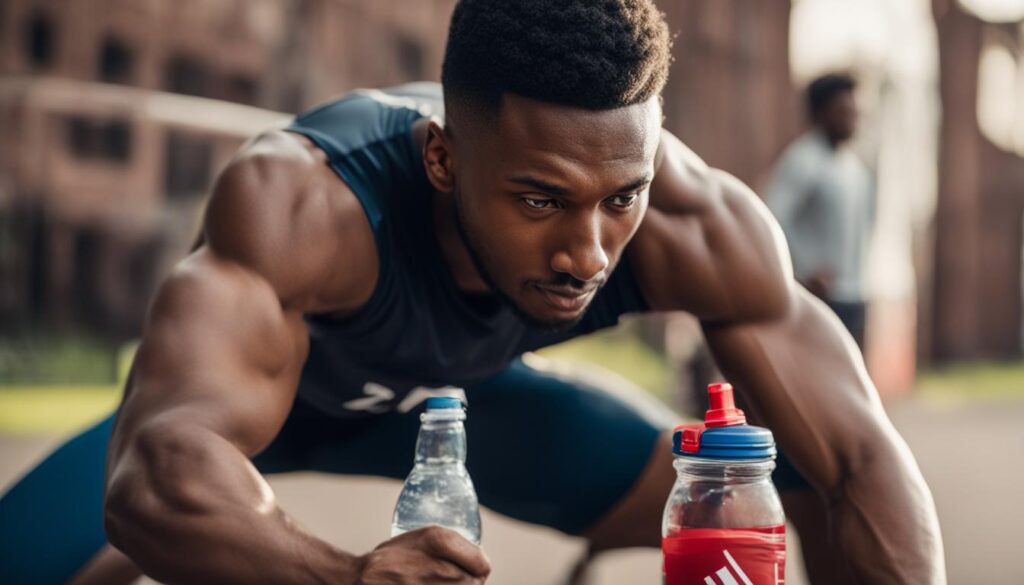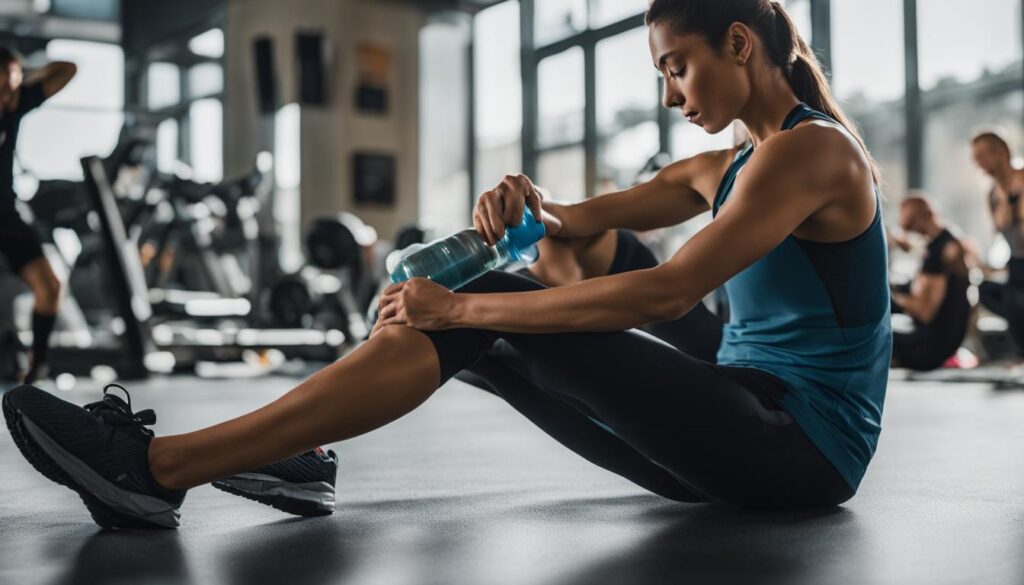Leg cramps are a common phenomenon that many individuals experience during exercise, particularly in the legs and feet. But is there a direct link between leg cramps and physical activity? Let’s delve into the research and explore this intriguing topic.
Key Takeaways:
- Leg cramps can occur during exercise, especially in the legs and feet.
- Various factors, including dehydration, electrolyte imbalances, muscle fatigue, and underlying neurological issues, may contribute to the onset of leg cramps.
- Taking preventive measures such as staying hydrated, maintaining electrolyte balance, gradual progression in exercise, proper warm-up and stretching, and adequate rest can help reduce the frequency and intensity of leg cramps during physical activity.
- If leg cramps persist or are accompanied by other symptoms, it is advisable to consult a healthcare professional for further evaluation and guidance.
Causes of Leg Cramps During Exercise
Muscle cramps during exercise can have multiple causes, including:
- Dehydration: Inadequate fluid intake and excessive sweating during exercise can lead to dehydration, increasing the risk of muscle cramps.
- Electrolyte Imbalances: Low levels of essential electrolytes like potassium, calcium, or magnesium can disrupt the normal muscle function and contribute to cramping.
- Initiation of New Exercise: Starting a new exercise routine or engaging in intense physical activity without proper conditioning can strain the muscles and trigger cramps.
- Muscle Fatigue: Prolonged or intense exercise can cause muscle fatigue, making them more susceptible to cramps.
- Neuromuscular Control: Issues with nerve signaling and muscle control can result in abnormal muscle contractions and cramps during exercise.
- Underlying Neurological Conditions: Certain neurological disorders or conditions, such as nerve compression or neuropathy, can increase the likelihood of experiencing leg cramps during exercise.
While electrolyte imbalances, especially low potassium levels, are commonly associated with muscle cramps, the precise mechanisms connecting these factors to exercise-related cramps are not fully understood at this time.
Expert Insight:
“Muscle cramps during exercise can be attributed to various factors, ranging from dehydration and electrolyte imbalances to muscle fatigue and underlying neurological issues. It’s crucial to maintain proper hydration, electrolyte balance, and gradually increase exercise intensity to minimize the risk of cramps.”
| Causes | Impact |
|---|---|
| Dehydration | Increases the likelihood of muscle cramps during exercise |
| Electrolyte Imbalances | Disrupts normal muscle function and contributes to cramping |
| Initiation of New Exercise | Strains the muscles, leading to cramps |
| Muscle Fatigue | Weakens the muscles, making them more prone to cramps |
| Neuromuscular Control | Interferes with proper muscle signaling, increasing the risk of cramping |
| Underlying Neurological Conditions | Predisposes individuals to muscle cramps during exercise |
Although the exact causes of leg cramps during exercise continue to be studied, addressing these various factors through proper hydration, nutrition, and gradual training can help minimize their occurrence and optimize athletic performance.
Prevention of Leg Cramps During Workout
Taking preventive measures can help reduce the occurrence of leg cramps during physical activity. To avoid leg cramps during a workout, the following strategies can be adopted:
- Stay Hydrated: Drinking enough fluids before, during, and after exercise is essential to prevent leg cramps
- Maintain a Balanced Diet: Including adequate amounts of electrolytes, such as potassium, calcium, and magnesium, in your diet can be beneficial
- Warm-up and Stretch: Performing proper warm-up and stretching exercises before workouts helps prepare the muscles for activity and may reduce the risk of cramping
- Gradually Increase Intensity and Duration: Slowly increasing exercise intensity and duration over time allows the muscles to adapt and may help prevent muscle cramps
By incorporating these strategies into your workout routine, you can minimize the chances of experiencing leg cramps during physical activity.
Hydration and Leg Cramps
“Staying hydrated is crucial to maintaining proper muscle function and preventing leg cramps during a workout.” – [Insert expert quote here]
Proper hydration plays a significant role in preventing muscle cramps during exercise. When we sweat during physical activity, our bodies lose fluids and electrolytes, which can lead to dehydration and imbalances in essential minerals. These imbalances can increase the likelihood of experiencing leg cramps.
Drinking enough water before, during, and after exercise helps replenish lost fluids and maintain optimal hydration levels. It is recommended to consume about 16 to 20 ounces of water or a sports drink containing electrolytes at least 2 hours before exercise. During exercise, regularly sipping on fluids every 15-20 minutes is advisable to prevent dehydration.

| Electrolyte | Function | Sources |
|---|---|---|
| Potassium | Aids in muscle function and nerve transmission | Bananas, oranges, potatoes, yogurt |
| Calcium | Essential for muscle contractions and bone health | Milk, cheese, leafy greens |
| Magnesium | Supports muscle and nerve function | Nuts, seeds, spinach, fish |
Consuming a balanced diet that includes foods rich in electrolytes like potassium, calcium, and magnesium can also help prevent leg cramps. These minerals play a crucial role in muscle function and nerve transmission. Including sources such as bananas, oranges, potatoes, yogurt, milk, cheese, leafy greens, nuts, seeds, spinach, and fish in your meals can help ensure an adequate intake of these essential electrolytes.
Additionally, before engaging in physical activity, it is essential to perform proper warm-up exercises and stretch the muscles to prepare them for the workout ahead. This step helps improve blood flow, flexibility, and overall muscle function, reducing the risk of cramping.
Finally, gradually increasing exercise intensity and duration allows the muscles to adapt and become stronger over time. Sudden, intense workouts can put excessive strain on the muscles, increasing the likelihood of cramps. By gradually progressing in your workouts, you give your muscles time to adjust and reduce the risk of cramping.
Exercises that can cause leg cramps
While leg cramps can occur during any type of exercise, certain activities have been associated with a higher risk. These exercises often involve repetitive motions or prolonged muscle contractions, which can lead to muscle fatigue and cramping. It’s important to note that individual factors such as fitness level and conditioning can also impact the likelihood of experiencing leg cramps during these exercises.
Below are some exercises that have been reported to cause leg cramps:
- Running: Engaging in prolonged running sessions or sudden increases in distance can strain the leg muscles, potentially leading to cramps.
- Cycling: The continuous pedaling motion in cycling can cause muscle fatigue and cramping, especially if proper form and conditioning are lacking.
- Swimming: Frequent kicking movements during swimming can put strain on the leg muscles, increasing the risk of cramps.
- Weightlifting: Lifting heavy weights or performing repetitive exercises without sufficient rest can result in muscle fatigue and cramps.
It’s crucial to listen to your body during exercise and take breaks when necessary. Gradually increasing the intensity and duration of your workouts, along with proper warm-up and stretching routines, can help prevent leg cramps. Remember to stay hydrated and maintain a balanced diet that includes essential electrolytes to support muscle function and avoid dehydration.
Performing exercises that involve repetitive motions or prolonged muscle contractions, such as running, may increase the likelihood of experiencing leg cramps.
Leg Cramps After Exercise
Leg cramps can be a frustrating experience during exercise, but what about after the workout? It’s not uncommon to continue feeling the effects of leg cramps even after you’ve finished your physical activity. There are several factors that can contribute to leg cramps occurring after exercise.
One possible cause of leg cramps after exercise is muscle fatigue. When you push your muscles to their limits during a workout, they can become exhausted and more prone to spasms and contractions. These spasms can lead to cramps and discomfort, even after you’ve stopped exercising.
Another factor that can contribute to leg cramps after exercise is electrolyte imbalances. When you sweat during a workout, your body loses important electrolytes like potassium, calcium, and magnesium. These electrolytes play a crucial role in muscle function, and when they are depleted, it can lead to muscle cramps.
In addition to muscle fatigue and electrolyte imbalances, dehydration can also play a role in post-workout leg cramps. When you don’t drink enough fluids during your workout or fail to properly rehydrate afterwards, your muscles may not receive the necessary hydration they need to function properly. This can increase the likelihood of experiencing leg cramps.
To alleviate leg cramps after exercise, it’s important to prioritize proper post-workout recovery. This includes rehydrating your body by drinking plenty of fluids, especially water. Additionally, giving your muscles time to rest and recover is essential. Taking breaks between workouts and ensuring you get adequate sleep can help prevent muscle fatigue and reduce the occurrence of leg cramps.
While leg cramps after exercise can be uncomfortable, they are often temporary and can be managed with the right strategies. By understanding the potential causes and taking steps to prevent them, you can minimize the discomfort and continue enjoying your workouts.
Treatment for Exercise-Related Leg Cramps
When it comes to treating exercise-related leg cramps, there is no one-size-fits-all approach. However, there are several strategies that can help provide relief and prevent future occurrences of leg cramps.
- Stretching and Massage: One effective method for relieving leg cramps is to gently stretch and massage the affected muscle. This can help relax the muscle and alleviate the cramp.
- Heat or Cold Application: Applying heat or cold to the painful area can also provide temporary relief from leg cramps. You can use a heating pad, warm towel, or an ice pack to soothe the muscle.
- Over-the-Counter Pain Relievers: Taking over-the-counter pain relievers such as ibuprofen or acetaminophen can help reduce the discomfort caused by leg cramps.
- Muscle Relaxants: In some cases, muscle relaxants may be prescribed by a healthcare professional to help relax the muscles and alleviate leg cramps.
If leg cramps are caused by underlying factors such as fluid and electrolyte imbalances or medication side effects, addressing these issues may be necessary for effective treatment. Consulting a healthcare professional can help determine the best course of action for individual cases.
Comparison of Treatment Options for Exercise-Related Leg Cramps
| Treatment Option | Description | Pros | Cons |
|---|---|---|---|
| Stretching and Massage | Gently stretching and massaging the affected muscle | – Provides immediate relief – Can be done at home |
– May not prevent future cramps – May require assistance for hard-to-reach areas |
| Heat or Cold Application | Applying heat or cold to the painful area | – Soothes the muscle – Easy to do at home |
– Temporary relief – May not prevent future cramps |
| Over-the-Counter Pain Relievers | Taking medications like ibuprofen or acetaminophen | – Reduces pain and discomfort – Readily available |
– Temporary relief – May have side effects |
| Muscle Relaxants | Prescribed medication to relax the muscles | – Provides relief for severe cramps – Muscle relaxation |
– Requires a prescription – May have side effects |
Remember, it’s important to consult with a healthcare professional for a proper diagnosis and personalized treatment plan for exercise-related leg cramps.
Managing Leg Cramps During Physical Activity
When engaging in physical activity, it is crucial to effectively manage and prevent leg cramps. By implementing a few strategies, you can reduce the likelihood of experiencing cramps during your workouts. Here are some tips on how to avoid leg cramps when working out:
- Listen to your body: Pay attention to any signs of an impending leg cramp. If you feel one coming on, stop or reduce the intensity of your exercise and stretch the affected muscle. This can help alleviate the cramp and minimize discomfort.
- Massage and temperature therapy: Giving a gentle massage to the cramped muscle and applying heat or cold to the area can offer relief. Experiment with what works best for you, as temperature therapy can vary from person to person.
- Stay hydrated: Dehydration can contribute to leg cramps, so it’s important to drink enough fluids before, during, and after your workout. Hydrating properly helps maintain electrolyte balance, which is crucial for muscle function.
- Maintain electrolyte balance: Consuming a balanced diet that includes minerals like potassium, calcium, and magnesium can help prevent leg cramps. These electrolytes play a vital role in muscle contraction and relaxation.
- Gradual progression: Avoid pushing yourself too hard or jumping into intense workouts without proper preparation. Gradually increase your exercise intensity and duration over time to allow your muscles to adapt and reduce the risk of cramping.
- Warm-up and stretching: Before engaging in any physical activity, perform a proper warm-up and stretching routine. This helps prepare your muscles for exercise and reduces the likelihood of cramps.
- Rest and recovery: Adequate rest and recovery are crucial for avoiding muscle fatigue, which can lead to leg cramps. Make sure to provide your body with enough time to replenish and repair after workouts.
By incorporating these strategies into your fitness routine, you can effectively manage leg cramps during physical activity and enjoy a smoother and more comfortable workout experience.

Conclusion
Leg cramps are a common occurrence during exercise, particularly in the legs and feet. While the exact cause of these muscle cramps is not fully understood, various factors such as dehydration, electrolyte imbalances, muscle fatigue, and underlying neurological issues have been identified as potential contributors.
Although there is no definitive treatment for exercise-related leg cramps, there are preventive measures that can help manage and reduce their frequency and intensity. Staying hydrated by drinking enough fluids before, during, and after exercise is crucial. Maintaining a proper electrolyte balance, particularly by including foods rich in potassium, calcium, and magnesium in your diet, can also be beneficial.
Furthermore, warming up and stretching before workouts, as well as gradually increasing exercise intensity and duration, can help prepare the muscles for activity and minimize the risk of cramping. It’s important to listen to your body and not push beyond your limits to avoid muscle fatigue and strain. If leg cramps persist or are accompanied by other symptoms, it is recommended to consult a healthcare professional for further evaluation and guidance.
FAQ
Is there a connection between leg cramps and exercise?
Yes, leg cramps can occur during exercise, particularly in the legs and feet.
What are the causes of leg cramps during exercise?
Leg cramps during exercise can be caused by factors such as dehydration, electrolyte imbalances, muscle fatigue, and underlying neurological issues.
How can leg cramps during workout be prevented?
To prevent leg cramps during workouts, it is important to stay hydrated, maintain proper electrolyte balance, warm up and stretch before exercising, and gradually increase exercise intensity and duration.
Which exercises can cause leg cramps?
Exercises that involve repetitive motions, prolonged muscle contractions, or intense and prolonged physical activity, such as running, cycling, swimming, and weightlifting, can increase the risk of leg cramps.
Why do leg cramps occur after exercise?
Leg cramps can occur after exercise due to factors like muscle fatigue, electrolyte imbalances, and dehydration.
What is the treatment for exercise-related leg cramps?
The treatment for exercise-related leg cramps may involve stretching and massaging the affected muscle, applying heat or cold, taking pain relievers, using muscle relaxants, and addressing underlying fluid and electrolyte imbalances or adjusting medication.
How can leg cramps be managed during physical activity?
To manage leg cramps during physical activity, it is important to listen to your body, stop or reduce the intensity of exercise when a cramp occurs, stretch the affected muscle, massage the area, apply heat or cold, stay hydrated, maintain proper electrolyte balance, warm up and stretch before workouts, and ensure adequate rest and recovery.
What is the conclusion regarding leg cramps and exercise?
Leg cramps can be a common occurrence during exercise. Understanding the potential causes, taking preventive measures, and addressing individual factors can help reduce the frequency and intensity of leg cramps during physical activity.





